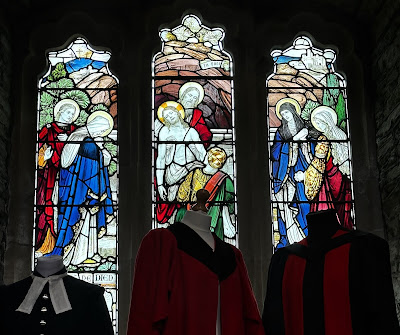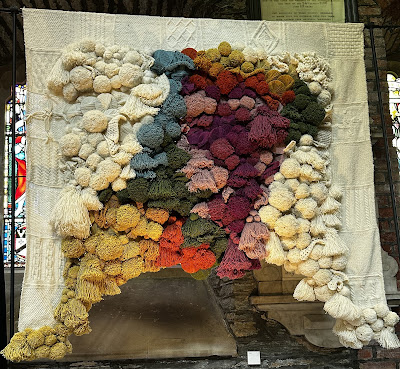July 9, 2024
We drove from Drumcliffe Church outside of Sligo to Londonderry/Derry, Northern Ireland, actually part of the United Kingdom and therefore a different country than the Republic of Ireland. Brits call the city Londonderry and Irish Republicans call it Derry. From here on out, I will refer to it as Derry for ease of typing.
There was no indication that we had left Ireland and entered Northern Ireland--no signs that said "Leaving the Republic of Ireland" or "Welcome to the United Kingdom" or even "Change your euros to pounds here." We made it into Derry and parked the car near an interesting series of photos on the city walls near the Heritage Tower.
"The Wall Museum Project" presents the words of local women who endured "The Troubles," a 30-year period of religious and nationalist conflict in Northern Ireland in the 1960s through 1990s. It's worth your time to click on the picture below and read the background of these photos as well as the thoughts of the women who lived through them.
Then take the time to read the childhood memories of the survivors. I can't imagine growing up in this environment.
There were also these pictures of a piece of public art called "Apprentice Angel." It shows a man with keys covering his suit. In his left hand he holds a large key recast from the Siege of Derry in 1689, and on his back there are angel wings and a lock. The artist, Ross Wilson, says that the sculpture represents the possibility of inward freedom for those who do not know outward freedom. Only we can "unlock" our own futures, notes Wilson. I would have loved to see the actual statue.
We passed through
Bishop's Gate, one of the original four gates to the city that was replaced with this triumphal arch in 1789.
According to signage on the wall, "It was here that James II demanded entry to the city during the 1689 siege. The present gate was built at the suggestion of Bishop Hervey in 1789 to celebrate the centenary of the siege. The head facing Bishop Street [below left] represents the river Boyne crowned by a laurel wreath; the date refers to the Battle of the Boyne in 1690. The head facing outwards [below right] is the river Foyle; the date 1689 and the ship breaking the boom recall the relief of the 1689 siege."
After we walked through the pedestrian tunnel, this was the view of the other side.
Bob had arranged for a private walking tour of Derry, and we had a little extra time before we were supposed to meet our guide, so we randomly visited St. Columb's Cathedral, which had, of all things, a special "Cloak Exhibit" that showcased cloaks from various realms and for various purposes--military, religious, drama, etc.--from the last few centuries.
The church is dedicated to St. Columba, an Irish monk who made converts here before being exiled to Scotland. In 1633, after the Protestant Reformation, this was the first Anglican cathedral to be built in Britain and Ireland and was actually the first non-Catholic cathedral to be built in all of Western Europe! A 226-foot-tall stone spire was completed in 1778 but posed some danger of collapsing into the church, so it was replaced in 1822 with a slightly shorter (but still very tall) spire.
There were many changes to the original structure over the years. (Note the US flag in the photo on the left. Not sure what that was about.)
The last change was the 1887 addition of the chancel, the area containing the altar and choir seen below.
The tiled central aisle is beautiful, as is the very old organ.
Okay, so what about this special "Festival of Cloaks"? I believe it was centered around the creation of one special piece of outerwear--St. Brigid's Cloak. But first, we had to examine an impressive line up of historical cloaks.
They made an interesting juxtaposition to the beautiful stained glass windows.
This cascade of crocheted poppies was one of my favorite items on display. It was surrounded by cloaks from World War I.
Aha! Here is a version of "St. Brigid's Cloak," one of four on display.

Brigid is the patroness saint of Ireland and one of its three national saints along with Patrick and Columba. Legend has it that in about 470, after her ordination by Patrick himself, she wanted to establish a monastery, and she selected a piece of land in Kildare. She asked the king for the land, but he refused to give it to her. The second time she asked, she specified just as much land as could be covered by her cloak. Feeling confident that this would not be much, the king agreed. Brigid took off her cloak and asked four of her followers to take a corner and walk away in four different directions. As they did this, the cloak grew and grew until it covered a substantial area of land. The king, stunned by this miracle, granted the land to Brigid, and on it she built her monastery. The king became her patron and eventually converted to Christianity.
The cloaks are made using locally sourced Irish wool and traditional stitches. The four cloaks on display involved 925 Irish crafters, including 250 local school children from the town of Kildare. I'm sure the pompoms and tassels and lacy chain mean something, but I am not sure what. These are my two favorites (above and below).
And what have we here? SHEEP! (One of my favorite animals.) And not just any old sheep . . .
. . . but lovely St. Brigid's flock!
Along the other side of the nave were costuming cloaks used in movies. For example, this clock was worn in a 1971 version of the movie A Death in Venice.
These were my favorites, two versions of Joseph's Coat of Many Colors. The one on the left was used in a Presbyterian church production, and the one on the right was from a theater production. They are both quite a bit more flamboyant than the ones I have seen in other productions of the play!
On our way out, I noticed something I have never seen in another church.
Each seat had a needlepoint pillow on the kneeling board in front of it. I wonder who made all of these? There were hundreds, each one unique.
In the foyer was a fiber version of St. Brigid and her cloak.
One last relic from the cathedral--this toilet with the tank at ceiling height. I guess if you have a tiny stall, you have to be creative, but wouldn't it be difficult to make repairs in that tank?
We had a ten-minute walk to where we planned to meet a guide for a walking history tour of the city. This gem was planted in the middle of the sidewalk, not appearing to be attached to a business. I love it.
The Diamond War Memorial is dedicated to the locals who served and died in World War I. Names of the fallen are engraved in raised letters on all four sides of the base. Winged victory stands on top, with a soldier representing the navy on the left and a soldier representing the army on the right. The statue was installed and dedicated in 1927.
Mention of those who served in World War II was added later.
This is the first of many, many murals we saw in Derry. Nearby signage says it pays tribute to generations of Derry factory girls. The city's largest shirt factory pioneered the use of sewing machines in 1855. By 1900 it was said that a shirt was completed in a Derry factory every two minutes, passing through the hands of eight workers. Once trained, women tended to keep not just the same job, but the same part of the job (e.g., hemming, collar turning, buttonholing, etc.) for life. By the mid-1920s, 18,000 people worked in 44 Derry factories, 90% of whom were women.
The factory featured above, Tillie & Henderson's, is referred to in Karl Marx's
Das Kapital. Marx's daughter visited it in 1891 to celebrate Derry factory girls becoming the first female workers in Ireland to become unionized.
Okay, now this mural makes sense!
And speaking of Derry girls, here is a mural of the Derry Girls, a popular British teen sitcom set in Derry. It premiered in 2018 and ran for three series. Bob and I tried tried to watch it, but after two shows, we gave up. Not our thing.
This, however, IS our thing:
Are those the coolest (no pun intended) chairs you've ever seen?
























































(Bob) Some fun stuff on the church. I loved the collection of cloaks and the coats of many colors. It was absolutely amazing to learn about the history of Ireland/Northern Ireland, which I knew little about and learned that what I knew was mostly backwards, even though what I know now is still very little, but comparably much more than before. For me, Northern Ireland was about the history, particularly the conflicts. Ireland was about beautiful scenery and castles.
ReplyDelete